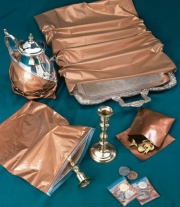Corrosion Intercept
Description
[Intercept Technology, Inc.] A registered trademark for a series of products made from a patented plastic barrier film. Corrosion Intercept® was developed by Lucent Technology/Bell Labs, who then licensed the patent to Intercept Technology in 1983 for development and marketing. Corrosion Intercept® film contains highly reactive copper particles in an inert plastic (e.g. Polyethylene) matrix. This forms a reactive barrier for corrosive and oxidative gases. According to their website, Corrosion Intercept® (CI) has the more recognizable Copper color, but it is designed for lighter corrosion duties than Static Intercept®. CI is the preferred choice for museum, archival, and consumer applications for protection of Silver, Copper, Brass, Bronze, Iron, and Steel in addition to CDs, photographic prints, film, books, and works of art.
Applications
Personal Risk
- CI is volatile free, safe, clean protection.
- Corrosion Intercept: [Safety Data Sheet]
Environmental Risk
- Corrosion Intercept uses a #4 recyclable, reusable resulting in a low carbon footprint
Working Properties
- Expected Corrosion Protection Term: 3-7 Years; multiple years of protection based on material style, gauge, and aggressive environment level exposure
- Needs to be replaced when metallic particles turn black
Forms/Sizes
- Corrosion Intercept® is available as open top pouches, zip-close bags, and coin storage cases. It is also available in films, sheets and larger sizes.
Resources and Citations
- Intercept Technologies: Website
- Rachael Perkins Arenstein, Lisa Goldberg, and Eugenie Milroy, ‘Support and Rehousing for Collection Storage’ In ‘Preventive Conservation: Collection Storage’ Lisa Elkin and Christopher A. Norris (eds.), Society for the Preservation of Natural History Collections, New York. 2019.
- Seco Industries: http://www.seco-ind.com/Packaging_CorrosionIntercept.htm
- University Products: http://www.archivalsuppliers.com
